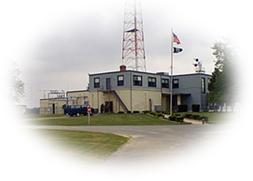





Early in 1967 initial surveys were conducted for installation of equipment under the project name PRICILLA ELLEN (SCOPE CONTROL) to support the MYSTIC STAR network which eventually took over the Aeronautical station mission. In 1967 a survey was conducted for location of a communications satellite terminal at the Brandywine site. Installation of the facility was started in October and completed in early January 1968.
In early 1969, the Department of Defense directed that HF facilities in the Washington, DC area be consolidated. Under this program, the Brandywine was assigned additional HF trunks to Fort Allen, Puerto Rico, Pirmasens Germany, and to the Navel Emergency Command Post Afloat. In 1973 Strategic Air Command (SAC) began upgrading and replacing their GIANT TALK facilities in the United States. Brandywine was selected to be the receiver site for the new Andrews GIANT TALK facility.The Gateway AN/FSC-82 installations began in 1980. The AN/FSC-82 provided secure satellite access from National Command Authority (NCA), Joint Chiefs of Staff (JCS), and common users to deployed tactical forces. The AFSATCOM installation was the first AFSATCOM Dual Consolidated Ground Terminal in the Air Force, so named because this system consisted of two AN/GSC-44. This AFSATCOM system provided the JCS connectivity for the primary and alternate National Military Command Centers (NMCC and ANMCC) with the AFSATCOM system worldwide including the Single Integrated Operational Plan (SIOP) forces, the Commander-in-Chiefs of the unified and specified commands, the National Emergency Airborne Command Post (NEACP), and the Worldwide Airborne Command Posts. On 5 August 1982 the AFSATCOM terminal was accepted and activated, and on 9 November 1982 the FSC-82 UHF Gateway installation was completed.
In January of 1982 Rockwell International Corporation began installation of the SCOPE SIGNAL III (SSIII) System. This was comprised of 9 solid state HF-8054 (2 - 30 Mhz) receivers under computer control and was an upgrade to their existing GIANT TALK system. The Radio Maintenance work center maintains 30 Collins HF Radio Receivers and all associated equipment. This equipment is a vital link in providing communications for Andrews AFB. The 19 651F-1 radios dedicated to the Special Air Missions communications system support the President of the United States, Department of Defense , Department of State, Chairman of the Joint Chiefs of Staff, 89th Airlift Wing air mission , and the Air Force Chief of Staff's Information and Telecommunications System of the American Air Forces supporting 17 Latin American countries. The facility's nine R-2208 radios supporting the Global Communications System (Scope Signal III) for Headquarters US Strategic Command. The final type of radios maintained are two RT-2200, these provide communication support for all Department of Defense aircraft under the Scope Command Communications system. AFSatcom/Wideband maintenance work supports long-haul, high-frequency (HF) radio communications and bulk secure communications for the Andrews Area Wideband System (Tri-Link) supporting the Presidential Radio Station, Joint Chiefs of Staff, Defense Information Systems Agency, AMC, and ACC. Satcom supports Satcom UHF and is the Alternate National Military Command Post with the same customers mentioned above. Equipment includes frequency diversity digital microwave radios (AN/FRC-173s), first and second level digital multiplexers (AN/FCC-98s and AN/FCC-99s), encryption devices (KG-81s), voice orderwires, patch bays, central distribution frame (CDF), ringing generators, signaling and termination equipment, and power rectifiers, as well satcom terminals (AN/GSC-44s), modems (958s), teletypes (UGC-129 ASR), and an RSU with AN/FCC-100 (V7) first level multiplexer.AFSatcom Operations primary mission is to transmit Emergency Action Messages (EAMs) supporting the National Military Command Center (NMCC). Other users are the National Airborne Operations Center (NAOC), launch control centers, nuclear submarines, recon aircraft and battlefield commanders worldwide.
The BWN Patch & Test Facility PTF is a small facility consisting of 90 active voice and data circuits. These circuits are made of telephone, fax, HF radio, satellite and microwave equipment; combined they make up eight trunks and two microwave links.
